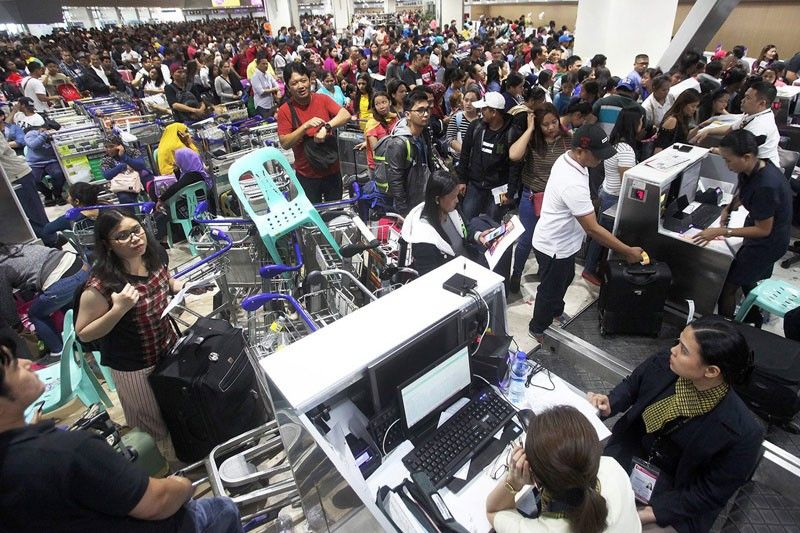CAAP: Xiamen Air black box to be sent abroad

MANILA, Philippines — The black box and flight data recorder of the Xiamen Air passenger aircraft that figured in a mishap at the Ninoy Aquino International Airport last week would be taken to either Japan or Singapore for examination, the Civil Aviation Authority of the Philippines (CAAP) said.
CAAP spokesman Eric Apolonio said that while they prefer to have the two equipment checked in Singapore which is nearer, the procedure could take longer as the city state is deluged with such requests.
“There are two choices where the black box and the flight recorder will be brought either to Singapore or Japan,” Apolonio said. In Singapore, facilitation of request for examination is on a “first come first serve basis” as there are plenty of such requests to deal with. In Japan, the “line is shorter,” he added.
He also said aircraft investigators revisited the site where the Air Xiamen flight MF8667 ended up after skidding off the runway upon landing last Aug. 16 during bad weather. While nobody was hurt in the accident, it paralyzed operations at NAIA for 36 hours. A source at the CAAP said that based on initial investigation, the pilot had claimed being temporarily blinded by heavy rain.
But the same source said a recording of the conversation between the air traffic controller and the pilots indicated no distress message or anything unusual. The mishap took place at 11:55 p.m. or minutes after their last conversation at 11:30.
“All the technical details encoded on the flight data recorder will help in the analysis on the condition of the Boeing 737 plane when we bring it to Singapore or Japan while the statement of the pilot and crew is vital to determine human factor,” Apolonio said.
The pilots and crew of the Xiamen flight are still under investigation by the CAAP board of investigators. Drug and alcohol tests for the pilots yielded negative results.
“They can only leave after questioning from our Aircraft Accident Investigation and Inquiry Board (AAIIB) investigators,” Apolonio said.
The amount Xiamen Air may have to pay the government is unlikely to reach half a billion pesos, according to the Manila International Airport Authority (MIAA).
MIAA general manager Ed Monreal said MIAA is still in the process of estimating costs and damage from the Xiamen mishap.
Monreal on Tuesday said initial calculations showed that Xiamen will have to pay P15 million for manpower as well as the rental costs of crane and other equipment that were used to remove the aircraft from the runway.
Monreal, however, stressed he is not expecting the amount to go higher than P500 million.
Airlines, for their part, may file separate cases against Xiamen Air to recover their own losses from the accident.
Monreal also said there is a need for the construction of a new airport with two main runways.
“The best basic solution is to construct an airport with at least two parallel runways. But these runways should be far apart, we have to consider the safety. If there’s an incident like this one affecting the main runway, there will be another or alternate runway we can use,” he said.
CAAP in 2014 had pushed for the construction of a parallel runway at the NAIA in a bid to ease congestion at the airport.
Former CAAP deputy director general Capt. John Andrews said the construction of a parallel runway at NAIA could increase the airport’s capacity from 40 to about 60 aircraft movements per hour. The planned runway would be constructed south of the existing runway 08/24 at the 400-hectare NAIA complex.
NAIA was built in 1981 with two intersecting runways – the primary runway 06/24 and secondary runway 13/31. To limit aircraft movement to 40 slots per hour, the CAAP transferred the general aviation flights to Sangley airport in Cavite. However, the plan of NAIA runway improvements did not push through.
Several flights including PAL, Cebu Pacific and other airlines were cancelled, diverted or delayed following the Xiamen mishap.
“The weekend closure of the Philippine capital’s main airport due to a stalled Xiamen Airlines jet was an ‘eye opener’ for authorities to improve protocols,” Tourism Secretary Bernadette Romulo-Puyat said in a television interview on Wednesday.
She said the country was “on track” to meet its tourist arrival targets due to the recent upgrade of air terminals, including the New Mactan-Cebu Airport. The Philippines is aiming for 7.4 million visitors this year and 12 million in 2022. – With Richmond Mercurio
- Latest
- Trending


























